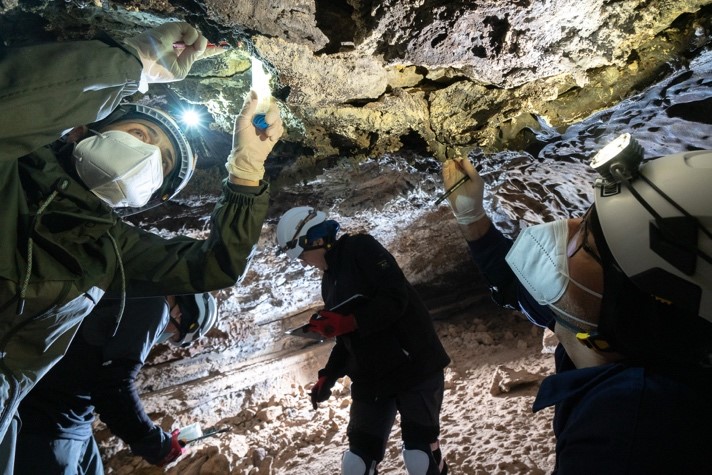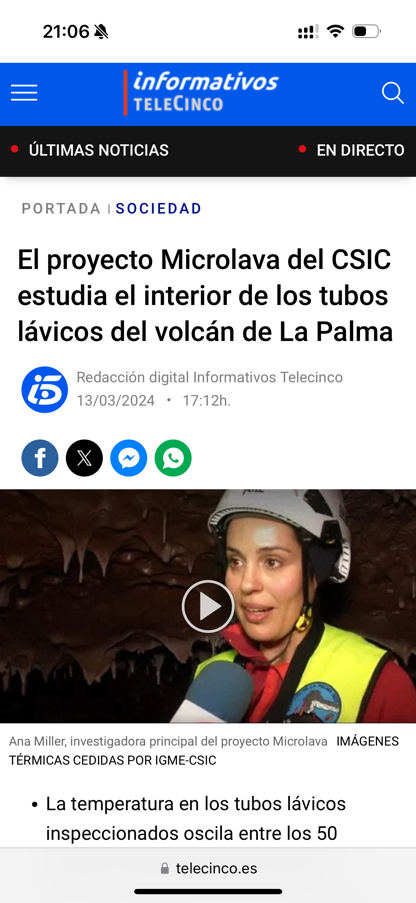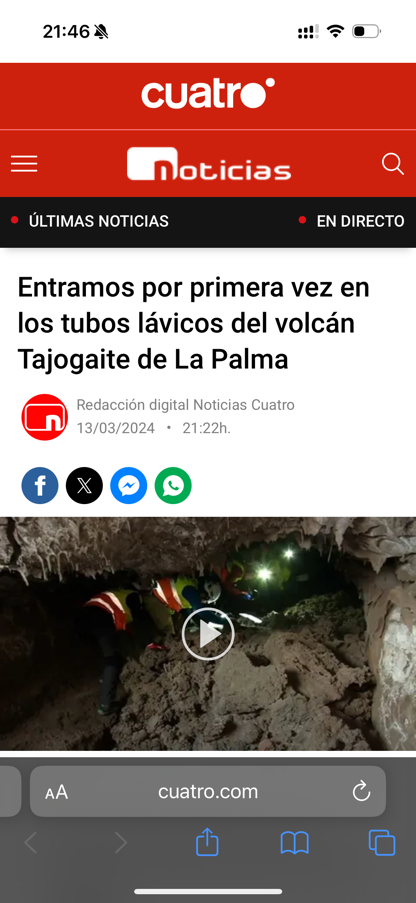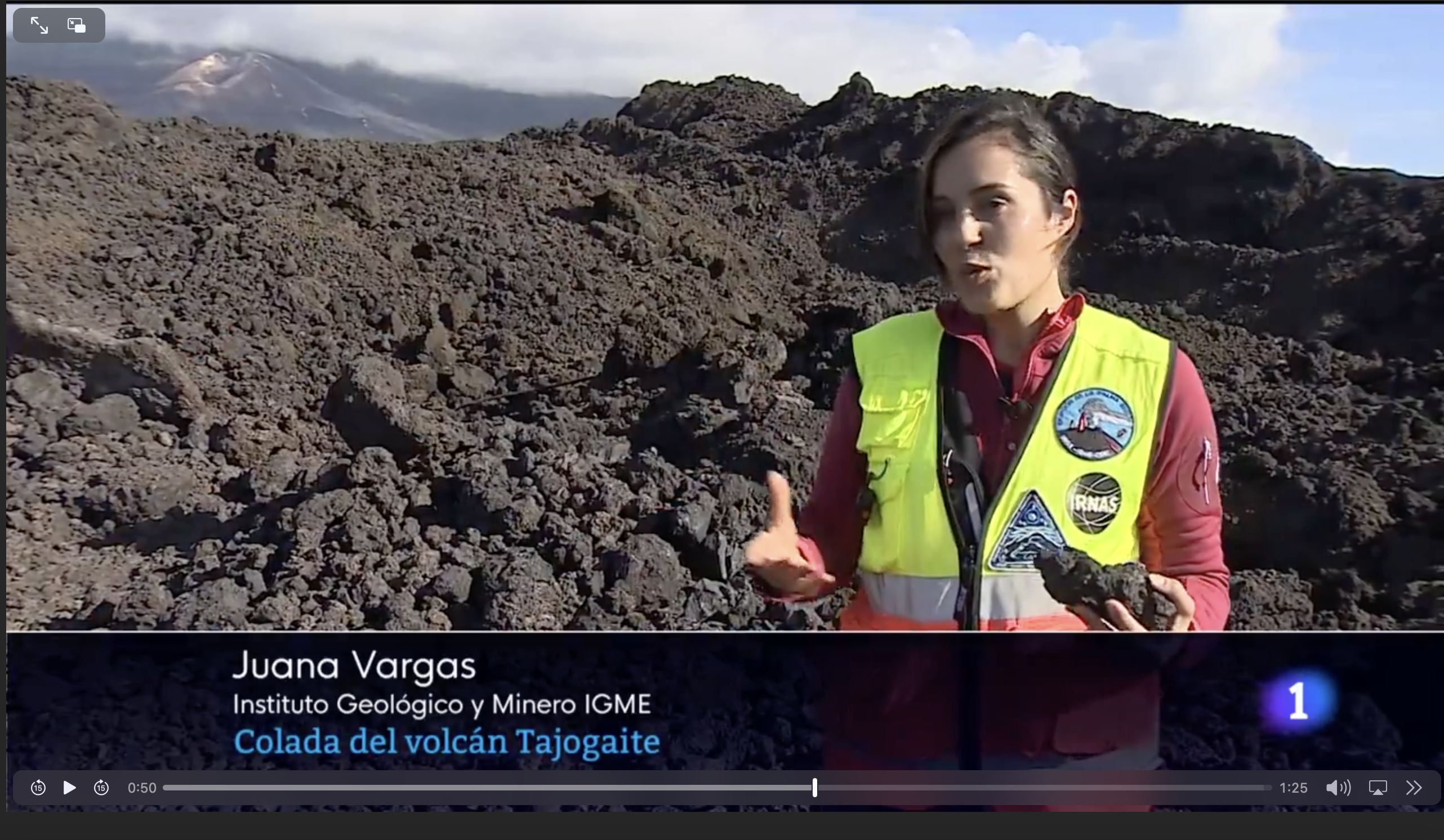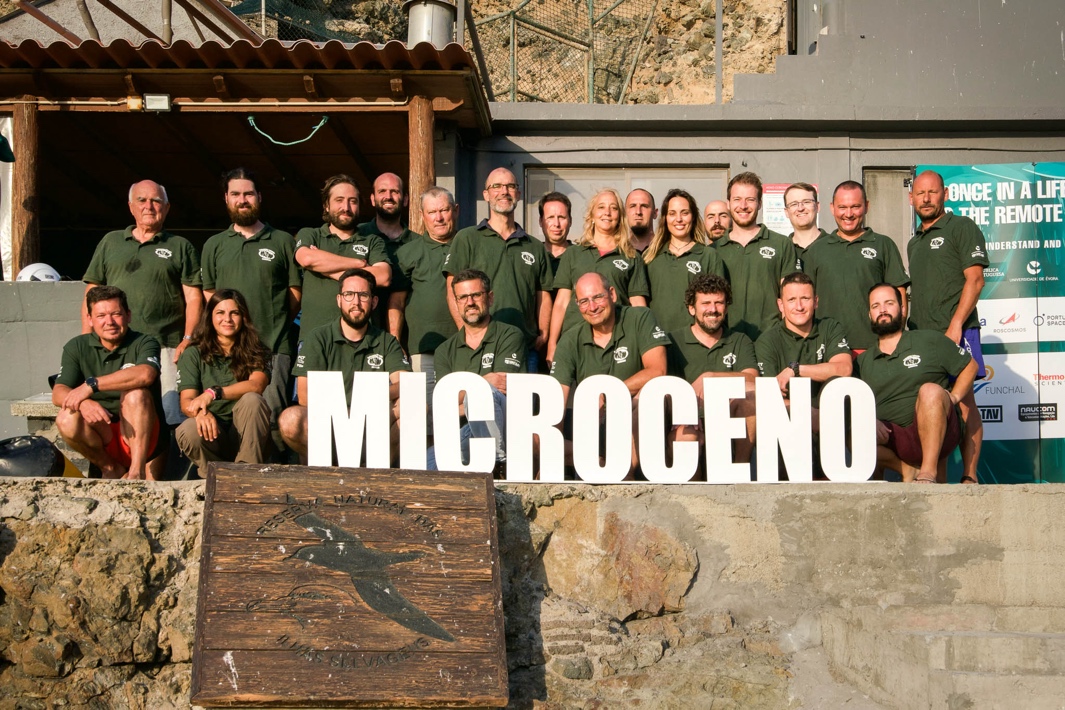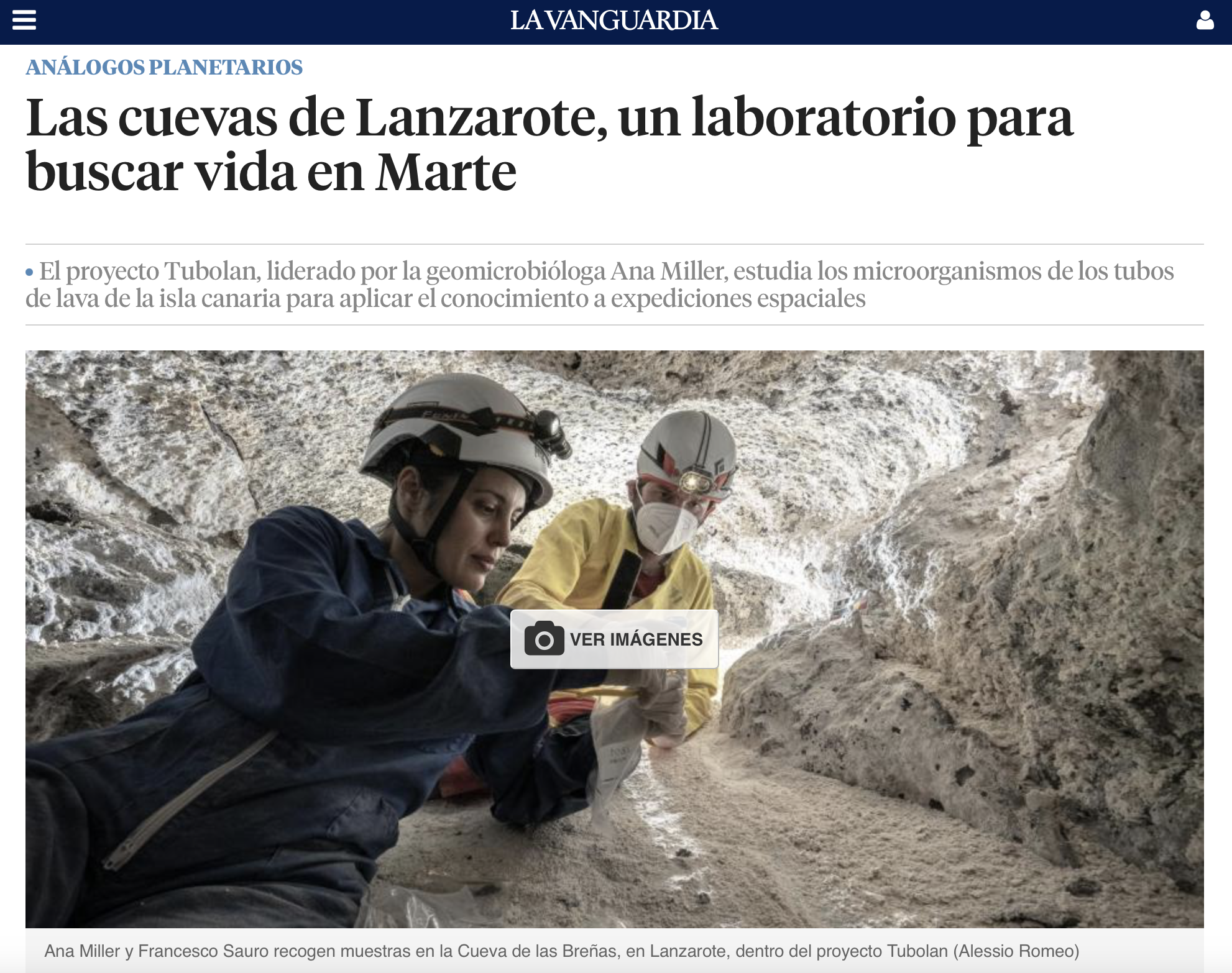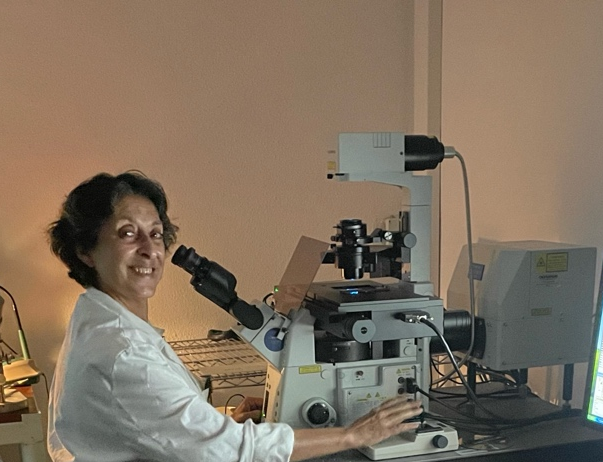Group
Geomicrobiology and Biogeochemistry
BIOGEOCOM
Description
BIOGEOCOM is an emerging research group dedicated to exploring the interactions between microorganisms, minerals, and organic matter in complex environments, including subterranean ecosystems (caves and mines), stone cultural heritage, soils, and sediments. A key goal is focused on the geomicrobiology of volcanic caves, specifically lava tubes, to understand the role of microorganisms in mineral dissolution and biomineralization processes, shedding light on the formation of speleothems, rock bioweathering and pedogenesis in volcanic regions.
BIOGEOCOM has pioneered interdisciplinary approaches that combined classical microbiology, advanced microscopy, metagenomics, mineralogy, and geochemistry, leading to breakthroughs in geomicrobiology of lava tubes from the Canary Islands (Spain), Selvagens (Portugal), Azores (Portugal), Easter Island (Chile), Mount Etna (Italy), and Galapagos Islands (Ecuador). Our research includes the identification of organic biomarkers and traces of microbial life (known as biosignatures) archived in speleothems, providing valuable insights into past environmental conditions and the origins of life on Earth, critical to the field of astrobiology. Through this work, BIOGEOCOM also lays the groundwork for detecting microbial life in similar environments on other planets. This expertise has been instrumental in collaborations with NASA and the European Space Agency (ESA), contributing to the PANGAEA and CAVES astronaut training programs. These involved designing geomicrobiological sampling techniques for astronauts to use in planetary lava tubes, crucial for future missions to the Moon and Mars. This has positioned BIOGEOCOM at the intersection of geomicrobiology and planetary exploration, which is pivotal for both understanding life on Earth and exploring the potential for life elsewhere in the universe.
Objectives
The main goal of the Geomicrobiology and Biogeochemistry research group consists in investigating the diversity, function and dynamics of microbial communities from complex ecosystems to understand which microorganisms grow in these harsh environments, how do they do it (i.e. which metabolic mechanisms and pathways are utilized, and what is their role in biogeochemistry cycling.
The specific objectives for addressing this investigation involve:
- Morphological and mineralogical characterization of solid substrates colonized by microorganisms.
- Study of microbial diversity, function and dynamics using metagenomics.
- Isolation, culture and characterization of isolated microorganisms, and potential description of novel species.
- Characterization and screening of antimicrobial and enzymatic activities of the isolated microorganisms.
- Recognition of microbe-mineral interactions and biosignatures preserved in the rock record plausible for the understanding of the origin of life on Earth and to help life-detection on other planets, based on a wide range of microscopy and chemical analyses.
- In-depth organic geochemical characterization of secondary mineral deposits to establish their biogenicity and provide information on past environmental changes preserved in minerals.
This multidisciplinary approach allows us to understand the role of microorganisms in the formation and dissolution of minerals, the erosion and alteration of rocks, the mobilization of metals from soil and sediments, the bioremediation of metal-contaminated soils and waters, fossilization mechanisms, as well as the biotransformation of elements. In addition, by studying microbe-mineral interactions and the molecular characterization of the organic fraction preserved in speleothems, we aim to contribute to the understanding of the origin of life on Earth and possibly on other planets, as well as to reconstruct environmental changes registered in minerals.
Due to the increasing demand in the discovery of new bioactive compounds of interest for the pharmaceutical industry or the recovery of the environment, our group also investigates extremophilic microorganisms, and their secondary metabolites, isolated from pristine environments, such as volcanic and salt caves.
To carry out these investigations, we apply a wide range of analytical and imaging techniques including next generation sequencing, classical microbiology, mineralogy, organic geochemistry and advanced microscopy (FESEM, FIB-SEM, TEM, CLSM, Epifluorescence, micro-CT) in order to advance scientific knowledge on the role of microorganisms and their interactions with geological substrates.
Current Projects
2024 – 2025: Title: “Microbial Biomineralization for Sustainable Applications (MicroApp)”. Entidad financiadora: CSIC, Programa de Cooperación Científica i-COOP (ref. COOPB23099). IP: A.Z. Miller (IRNAS-CSIC)
10/2022 – 09/2025: Title: “A biodeterioration model to predict biological impact on exposed rock surfaces and open-air rock-art” (ROCKinBIO), Entidad financiadora: Fundação para a Ciencia e a Tecnologia, Portugal (ref. 2022.04830.PTDC). IP: Joana Marques (CIBIO, Porto), co-IP: A.Z. Miller (IRNAS-CSIC).
2023 – 2025: Title: “Pioneer microbial biocenosis and minerogenesis on newly emplaced rocks and lava tubes by Cumbre Vieja volcanic eruption (MICROLAVA)”. Proyectos de investigación de Excelencia de la Junta de Andalucía (PROYEXCEL_00185). IP: A.Z. Miller (IRNAS-CSIC)
2022 – 2024: Title: “Comunidades microbianas pioneras en depósitos volcánicos recientes de La Palma: potencial para su meteorización”. Proyectos de Transición Ecológica y Digital, Ministerio de Ciencia e Innovación (TED2021-130683B-C22). IP: A.Z. Miller (IRNAS-CSIC)
01/2022 – 12/2024: Title: “Estudio geomicrobiológico y biogeoquímico de espeleotemas, suelos y sedimentos: un enfoque multidisciplinar y transfronterizo”, CSIC, Proyecto Intramural Especial (PIE-20214AT021): IP: A.Z. Miller (IRNAS-CSIC)
03/2021 – 02/2025: Title: “Geomicrobiology of volcanic caves from pristine islands: potential for Astrobiology, Biotechnology and Paleoenvironmental Research (MICROCENO)”. Entidad financiadora: Fundação para a Ciencia e a Tecnologia, Portugal (ref. (PTDC/CTA-AMB/0608/2020). IP: A.Z. Miller (IRNAS-CSIC)
11/2020 – 12/2023: Title: “Discovering subsurface microbiota and biominerogenesis in lava tubes from Lanzarote (TUBOLAN)”, Spanish Ministry for Science Innovation and Universities, PID2019-108672RJ-I00 (Programa Estatal de I+D+i Orientada a los Retos de la Sociedad). PI: Ana Z. Miller.
Recent publications
- Palma V, De la Rosa JM, Onac BP, Martínez-Frías J, Caldeira AT, González-Pérez JA, Jiménez-Morillo NT, Miller AZ* (2024) Decoding organic compounds in lava tube sulfates to understand potential biomarkers in the Martian subsurface. Commun Earth Environ 5, 530. https://doi.org/10.1038/s43247-024-01673-4
- Daniel-Mozo M, Rombolá-Caldentey B, Mendoza I, Ragel P, De Luca A, Carranco R, Alcaide AM, Ausili A, Cubero B, Schumacher K, Quintero FJ, Albert A, Pardo JM (2024). The vacuolar K+/H+ exchangers and calmodulin-like CML18 constitute a pH-sensing module that regulates K+ status in Arabidopsis. Sci Adv. 2024 15;10(46) https://doi.org/10.1126/sciadv.adp7658
- Osman JR, Castillo J, Sanhueza V, Miller AZ, Novoselov A, Cotoras D, Morales D, 2024. Key energy metabolisms in modern living microbialites from hypersaline Andean lagoons of the Salar de Atacama, Chile, Science of The Total Environment 937, 173469, https://doi.org/10.1016/j.scitotenv.2024.173469
- Gutierrez-Patricio, S., Osman, J.R., Gonzalez-Pimentel, J.L., Jurado, V., Laiz, L., Láinez, A., Saiz-Jimenez, C., Miller, A.Z*. 2024. Microbiological exploration of the Cueva del Viento lava tube system in Tenerife, Canary Islands. Environmental Microbiology Reports 16, e13245. http://dx.doi.org/10.1111/1758-2229.13245
- Ghezzi D, Jiménez-Morillo NT, Foschi L, Donini E, Chiarini V, De Waele J, Miller AZ*, Cappelletti M. (2024). The microbiota characterizing huge carbonatic moonmilk structures and its correlation with preserved organic matter. Environmental Microbiome 19, 25.
- Silva I, Dias L, Salvador C, Miller AZ, Candeias A, Caldeira AT (2024). Microbial induced stone discoloration in Alcobaça Monastery: A comprehensive study. Journal of Cultural Heritage 67, 248–257. https://doi.org/10.1016/j.culher.2024.03.011https://doi.org/10.1186/s40793-024-00562-9
- Gatinho P, Salvador C, Gutierrez-Patricio S, Macedo-Arantes S, Martins MR, Silva A, Miller AZ, Caldeira AT (2024). From cultural and natural heritage to reservoir of biomedicine: Prospection of bioactive compounds produced by bacterial isolates from caves. International Biodeterioration & Biodegradation 190, 105773. https://doi.org/10.1016/j.ibiod.2024.105773
- Palma V, González-Pimentel JL, Jiménez-Morillo NT, Sauro F, Gutierréz-Patricio S, De la Rosa JM, Tomasi I, Massironi M, Onac BP, Tiago I, González-Pérez JA, Laiz L, Caldeira AT, Martínez-Frías J, Cubero B, Miller AZ (2024). Connecting molecular biomarkers, mineralogical composition, and microbial diversity from Mars analog lava tubes. Science of the Total Environment 913, 169583.
DOI: 10.1016/j.scitotenv.2023.169583 - Addesso R, Baldantoni D, Cubero B, De La Rosa JM, González Pérez JA, Tiago I, Caldeira AT, De Waele J, Miller AZ (2023). A multidisciplinary approach to the comparison of three contrasting treatments on both lampenflora community and underlying rock surface. Biofouling 39, 204-217.
DOI: 10.1080/08927014.2023.2202314 - De la Rosa JM, Pérez-Dalí SM, Campos P, Sánchez-Martín Á, González-Pérez JA, Miller AZ (2023). Suitability of Volcanic Ash, Rice Husk Ash, Green Compost and Biochar as Amendments for a Mediterranean Alkaline Soil. Agronomy 13, 1097.
DOI: 10.3390/agronomy13041097 - Nicolosi G, Gonzalez-Pimentel JL, Piano E, Isaia M, Miller AZ (2023). First Insights into the Bacterial Diversity of Mount Etna Volcanic Caves. Microbial Ecology 86, 1632-1645.
DOI: 10.1007/s00248-023-02181-2. - Miller AZ, Jiménez-Morillo NT, Coutinho ML, Gazquez F, Palma V, Sauro F, Pereira MFC, Rull F, Toulkeridis T, Caldeira AT, Forti P, Calaforra JM. (2022). Organic geochemistry and mineralogy suggest anthropogenic impact in speleothem chemistry from volcanic show caves of the Galapagos. iScience 25, 104556. DOI: 10.1016/j.isci.2022.104556
- Ferreira RL, Bernard E, Júnior CFW (…), Miller AZ (54/105), Frick W (2022). Brazilian cave heritage under siege. Science 375, 1238–1239. DOI: 10.1126/science.abo1973
- Jimenez-Morillo NT, Almendros G, Miller AZ, Hatcher PG, Gonzalez-Perez JA (2022) Hydrophobicity of soils affected by fires: An assessment using molecular markers from ultra-high resolution mass spectrometry. Science of the Total Environment 817, 152957.
DOI: 10.1016/j.scitotenv.2022.152957 - Wynne J, Titus T, Agha-Mohammadi A, and authors (Miller AZ 11/37), Williams KE. (2022). Fundamental Science and Engineering Questions in Planetary Cave Exploration. Journal of Geophysical Research: Planets. 127, e2022JE007194. DOI: 10.1029/2022JE007194
- Nicolosi G, Galdenzi S, Messina MA, Miller AZ, Petralia S, Sarbu SM, Isaia M (2022). Sulfidic habitats in the gypsum karst system of Monte Conca (Italy) host a chemoautotrophically supported invertebrate community. International Journal of Environmental Research and Public Health 19, 2671.
DOI: 10.3390/ijerph19052671 - García-Sánchez AM, Miller AZ, Caldeira AT, Cutillas C. (2022). Bacterial communities from Trichuris spp. A contribution to deciphering the role of parasitic nematodes as vector of pathogens. Acta Tropica 226, 106277.
DOI: 10.1016/j.actatropica.2021.106277 - Rodrigues A, Alves M, Gutierrez-Patricio S, Miller AZ, Macedo MF (2022). From biodeterioration to creativity: Bioreceptivity of Spruce Pine 87 Glass Batch by Fungi. Applied Sciences 12, 7672.
DOI: 10.3390/app12157672 - Macedo MF, Miller AZ, Pinheiro AC, Portugal A, 2022. Editorial – Application of Biology to Cultural Heritage. Applied Sciences 12, 841.
DOI: 10.3390/app12020841 - Pinheiro C, Miller AZ, Vaz P, Caldeira AT, Casanova C. (2022). Underneath the Purple Stain. Heritage 5, 4100-4113. DOI: 10.3390/heritage5040212
- Titus TN, Wynne JJ, Malaska MJ, et al. (Miller AZ 26/42), Wong UY (2021). A Roadmap for Planetary Caves Science and Exploration. Nature Astronomy, 5, 524–525. DOI: 10.1038/s41550-021-01385-1
- Sanmartín P, Miller AZ, Prieto B, Viles HA, (2021). Revisiting and reanalysing the concept of bioreceptivity 25 years on. Science of the Total Environment 770, 145314. DOI: 10.1016/j.scitotenv.2021.145314
- Wynne JJ, Howarth FG, Mammola S, and authors Miller AZ (39/56), (2021). A conservation roadmap for the subterranean biome. Conservation Letters 14, e12834. DOI: 10.1111/conl.12834
- De Deus M, Miller AZ, Jimenez-Morillo NT (2021). Molecular characterization of burned organic matter at different soil depths and its relationship with soil water repellency: a preliminary result. Agronomy 11, 2560. DOI: 10.3390/agronomy11122560
- Addesso R, Gonzalez-Pimentel JL, D’Angeli IM, De Waele J, Saiz-Jimenez C, Jurado V, Miller AZ, Cubero B, Vigliotta G, Baldantoni D, (2021). Microbial community characterizing vermiculations from karst caves and its role in their formation. Microbial Ecology 81, 884–896. DOI: 10.1007/s00248-020-01623-5
- Jurado V, D’Angeli I, Martin-Pozas T, Cappelletti M, Ghezzi D, Gonzalez-Pimentel JL, Cuezva S, Miller AZ, Fernandez-Cortes A, De Waele J, Sanchez-Moral S, Saiz-Jimenez C. (2021). Dominance of Arcobacter in the white filaments from the thermal sulfidic spring of Fetida Cave (Apulia, southern Italy). Science of the Total Environment 15, 149465. DOI: 10.1016/j.scitotenv.2021.149465
- Campos P, Knicker H, Miller AZ, Velasco-Molina M, De la Rosa JM (2021) Biochar ageing in polluted soils and trace elements immobilisation in a 2-year field experiment. Environmental Pollution 290, 118025. DOI: 10.1016/j.envpol.2021.118025
- Gonzalez-Pimentel JL, Martin-Pozas T, Jurado V, Miller AZ, Caldeira AT, Fernandez-Lorenzo O, Sanchez-Moral S, Saiz-Jimenez C (2021). Prokaryotic communities from a lava tube cave in La Palma Island (Spain) are involved in the biogeochemical cycle of major elements. PeerJ 9:e11386. DOI: 10.7717/peerj.11386
- Gutierrez-Patricio S, Gonzalez-Pimentel JL, Miller AZ, Hermosin B, Saiz-Jimenez C, Jurado V. 2021. Paracoccus onubensis sp. nov., a novel alphaproteobacterium isolated from the wall of a show cave. International Journal of Systematic and Evolutionary Microbiology 71, 004942. DOI: 10.1099/ijsem.0.004942
- Campos P, Miller AZ, Prats SA, Knicker H, Hagemann N, De la Rosa JM. (2020). Biochar amendment increases bacterial diversity and vegetation cover in trace element-polluted soils: A long-term field experiment. Soil Biology and Biochemistry 150, 108014. https://doi.org/10.1016/j.soilbio.2020.108014
- Pozo-Antonio JS, Sanmartín P, Serrano M, De la Rosa JM, Miller AZ, Sanjurjo-Sanchez J (2020). Impact of wildfire on granite outcrops in archaeological sites surrounded by different types of vegetation. Science of the Total Environment 747, 141143.
DOI: 10.1016/j.scitotenv.2020.141143 - De la Torre Noetzel R, Ortega García MV, Miller AZ, Bassy O, Granja C, Cubero B, Jordão L, Martínez-Frías J, Rabbow E, Backhaus T, Ott S, García Sancho LG, de Vera JP. (2020). Lichen Vitality After a Space Flight on Board the EXPOSE-R2 Facility Outside the International Space Station: Results of the Biology and Mars Experiment. Astrobiology 20, 583-600. DOI: 10.1089/ast.2018.1959
- D’Angeli IM, Naylor LA, Lee M, Miller AZ, Mylroie J, De Waele J. (2020). Light attenuation as a control for microbiogeomorphic features: Implications for coastal cave speleogenesis. Geomorphology 354, 107054. DOI: 10.1016/j.geomorph.2020.107054
- Miller AZ, De la Rosa JM, Jimenez-Morillo NT, Pereira MFC, Gonzalez-Perez JA, Knicker H, Saiz-Jimenez C (2020). Impact of wildfires on subsurface volcanic environments: New insights into speleothem chemistry. Science of the Total Environment 698, 134321.
DOI: 10.1016/j.scitotenv.2019.134321 - Miller AZ, García-Sánchez AM, Coutinho, ML, Costa Pereira MF, Gázquez F, Calaforra JM, Forti P, Martínez-Frías J, Toulkeridis T, Caldeira AT, Saiz-Jimenez C (2020). Colored Microbial Coatings in Show Caves from the Galapagos Islands (Ecuador): First Microbiological Approach. Coatings 10, 1134. DOI: 10.3390/coatings10111134
- Coutinho ML, Veiga JP, Macedo MF, Miller AZ (2020). Testing the feasibility of titanium dioxide sol-gel coatings on Portuguese glazed tiles to prevent biological colonization. Coatings 10, 1169. DOI: 10.3390/coatings10121169
Science Outreach
-
Exploración de los nuevos tubos de lava formados durante la erupción del Volcán Tajogaite en La Palma, Canarias (sept. – dic. 2021):
-
-
Informativos Telecinco (13/03/2024): https://www.telecinco.es/noticias/sociedad/20240313/octavio-fernandez-espeologo-tubo-lavico-volcan-tajogaite_18_011963793.html
-
Noticias Cuatro (13/03/2024): https://www.cuatro.com/noticias/sociedad/20240313/entramos-primera-vez-tubos-lavicos-volcan-tajogaite-palma_18_011966239.html
-
-
Impact of the eruption of the Tajogaite volcano on the pre-existing soils of La Palma (HIRES-SOM project):
-
Informativos Telecinco (14/03/2024): https://www.telecinco.es/noticias/sociedad/20240314/erupcion-palma-crecimiento-plataneras-lava_18_011975320.html
-
RTVE Canarias (13/03/2024): https://www.instagram.com/rtvecanarias/reel/C4dXtm-y2ek/
-
-
Expedición científica a las remotas Islas Salvajes, Portugal, en el marco del proyecto MICROCENO (julio 2021):
-
“Projecto Microceno: uma nova gruta nas ilhas mais distantes”. Revista National Geographic Portugaledition November 2021, pp. 38-49 https://nationalgeographic.pt/natureza/grandes-reportagens/2868-projecto-microceno-uma-nova-gruta-nas-ilhas-mais-distantes
-
Newsletter de la Agencia Espacial Portuguesa: “As grutas das Ilhas Selvagens podem ter vista para Marte”: https://ptspace.pt/pt/as-grutas-das-ilhas-selvagens-podem-ter-vista-para-marte/
-
Telediario RTP Madeira: https://www.rtp.pt/madeira/sociedade/microbiologia-e-mineralogia-das-grutas-vdeo_69572?fbclid=IwAR2a62Y_15kR8llWhFvqh1O4dnRfrLZTZiasALrFtU3RoyApr8Jx5_aNxbE
-
-
Estudio de la microbiota de los tubos de lava de Lanzarote, proyecto TUBOLAN:
-
La Vanguardia (25/05/2021): https://www.lavanguardia.com/ciencia/20210525/7471426/cuevas-lanzarote-laboratorio-buscar-vida-marte.html
-
Group Scientific and Technical Service
The IRNAS Confocal Microscopy Service provides its services both to members of the Institute itself and to other CSIC researchers. The Service includes initializing and running the equipment and optional technical assistance by the personnel responsible.
The Service has a Olympus FV1000 Spectral Confocal Microscope available to users.
Our users are mainly from the field of biology, although occasionally studies of materials can be carried out with our equipment.
The samples that we usually analyze are in vivo cultures of microorganisms, plant and animal tissues, biofilms and surface materials.
Contact: Instituto de Recursos Naturales y Agrobiología de Sevilla (IRNAS – CSIC) – Avda. Reina Mercedes, 10, 41012, Sevilla
Teléfono: 954624711, ext 440538
e-mail: servicio_microscopia[AT]irnas.csic.es
Responsable científico: Beatriz Cubero
Components
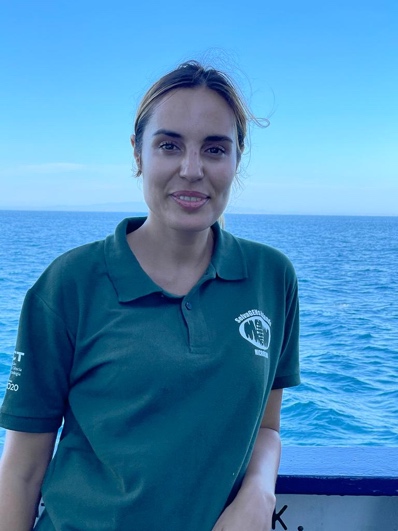
Ana Zélia Miller
Group leader
Senior Scientist at IRNAS-CSIC, where she leads the BIOGEOCOM group. She holds a PhD in Conservation Sciences from NOVA University of Lisbon and her line of research focuses on the geomicrobiology of subterranean environments, with emphasis on microorganism-mineral interactions, biomarkers of microbial life and biomineralisation in lava tubes.
ORCID: https://orcid.org/0000-0002-0553-8470
amiller[AT]irnas.csic.es

Alba Gómez Arias
Contracted Juan de la Cierva
Degree in Geology, Master in Geology and Environmental Management of Mineral Resources and PhD in the area of Industrial and Environmental Science and Technology at the University of Huelva (UHU), the latter in co-tutelle with the University of the Free State (UFS, South Africa).
Participation in national and international projects: ERA-MIN of HORIZON2020 (ERA-MIN_AMDREY_PCIN-2015-242), ERA-MIN3 of HORIZON-Europe (Tailing32Green), Unesco (UNESCO-IGCP682) and Selfaquasens PI of HORIZON-MSCA (Horizon-Europe 101131379 – SELFAQUASENS).
Diversos premios españoles e internacionales en las áreas de geología, tecnología y preservación medioambiental y sostenibilidad de recursos naturales
ORCID: https://orcid.org/0000-0001-6913-2499
alba.gomez[AT]irnas.csic.es

Beatriz Cubero
Senior Scientist
Degree in Biology and PhD in Genetics, University of Seville.
Keywords: Biotechnology, Molecular Biology, Abiotic Stress Physiology, Optical and Confocal Microscopy
bcubero[AT]irnase.csic.es
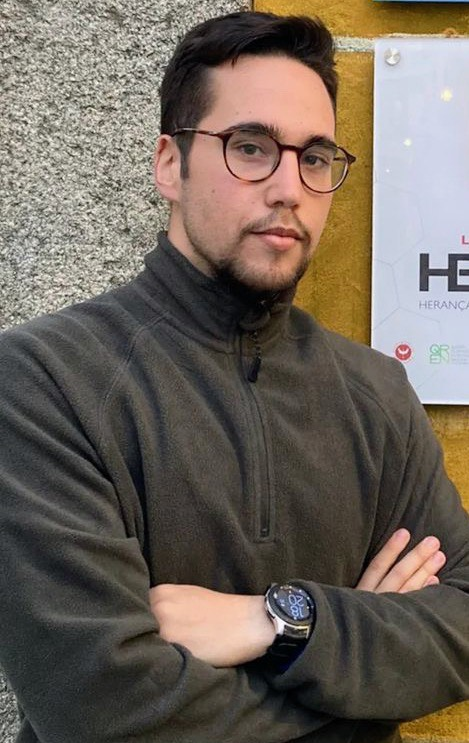
Pedro Jiménez Morillo
Graduate contract holder
Degree in Biotechnology at the Pablo de Olavide University and Specialisation Diploma in Bioinformatics Analysis at the same University.
Master’s Degree in Advanced Bioinformatics Analysis at the Pablo de Olavide University.
Master’s Degree in Teaching at the University Pablo de Olavide
Keywords: Bioinformatics, Microbiology, Biotechnology, Biogeochemistry, BigData.
pnjm[AT]irnas.csic.es
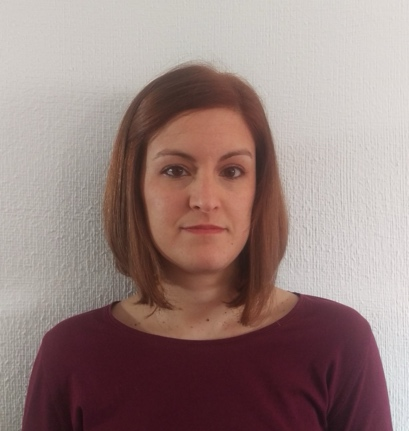
Sara Gutiérrez Patricio
Contract researcher
Degree in Biology, Master in Molecular Genetics and Biotechnology, and PhD in Biology from the University of Seville. Specialist in bacterial taxonomy, description and characterisation of new bacterial species.
Keywords: Microbiology, Molecular Biology, Biotechnology
ORCID:https://orcid.org/0000-0002-4225-0708
sara.gutierrez[AT]irnas.csic.es
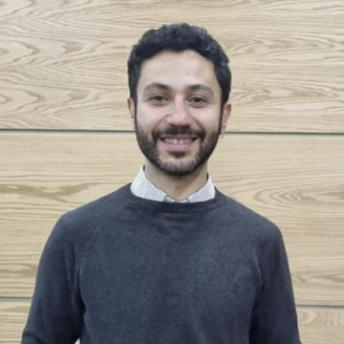
Jorge Osman
Guest researcher
Jorge Osman is a professor and senior researcher at the Universidad de Concepción (UdeC) in Chile. Using metagenomic, geochemical and microscopic tools, Jorge develops a line of research related to the geomicrobiology of microbialites present in the Salar de Atacama (Chile) within the framework of his Fondecyt project (IP) N°11220128 funded by the National Agency for Research and Development (ANID) of the Chilean government. In addition to answering fundamental questions related to microbiological, metabolic and mineralogical composition, he uses microcosms to predict potential changes in microbialite geomicrobiology due to water salinisation and climate change.
osman.jorge[AT]gmail.com

